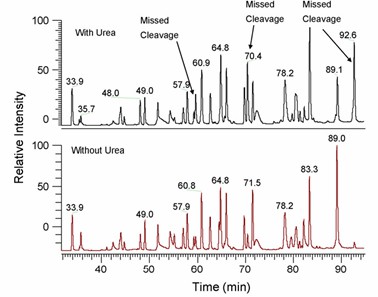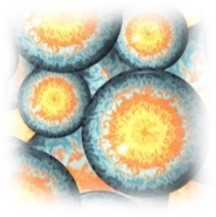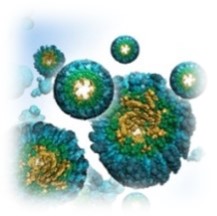Peptide mapping is a powerful tool in the field of proteomics, which is always uesd for protein characterization, quality control, biosimilar development, protein engineering and so on. Creative Proteomics provides comprehensive peptide mapping service that allows you to meet the requirements of the ICH Q6B guidelines.
Overview
Peptide mapping, also known as protein digest analysis, is a powerful analytical technique used in the field of biopharmaceutical characterization. It plays a crucial role in the characterization and quality control of protein-based drugs. Peptide mapping involves the enzymatic digestion of proteins into smaller peptide fragments, followed by their separation and identification using various analytical techniques such as liquid chromatography-mass spectrometry (LC-MS). This analytical approach provides valuable information about the primary structure, post-translational modifications, and overall integrity of the protein drug.
 Fig 1. HPLC-UV chromatograms for a peptide map of a monoclonal antibody with and without urea in the trypsin digestion step. (Woiwode, U., et al; 2018)
Fig 1. HPLC-UV chromatograms for a peptide map of a monoclonal antibody with and without urea in the trypsin digestion step. (Woiwode, U., et al; 2018)
How is Peptide Mapping Performed?
Primary amino acid sequences of protein-based biologic therapeutic products (such as monoclonal antibodies and antibody-drug conjugates) are frequently required by a number of regulatory organizations. One of the most effective and cutting-edge technologies in analytical chemistry for elucidating accurate and thorough peptide maps that include post-translational modifications is LC-MS/MS.
 Fig 2. Peptide mapping schematic diagrams of the amino acid sequence of VP proteins. (Anh K Lam., et al.; 2022)
Fig 2. Peptide mapping schematic diagrams of the amino acid sequence of VP proteins. (Anh K Lam., et al.; 2022)
Peptides generated when separate proteins or protein combinations are digested are studied by scientists. Proteins are first broken down enzymatically, then the resultant peptides are separated by liquid chromatography before being assessed by mass spectrometry. This procedure creates a "fingerprint" of the protein under test, or a collection of distinctive peptides. The theoretical mass/spectra of the sequences in the proteomics database are compared to the mass/spectra of the discovered unique peptides.
Application of Peptide Mapping
Peptide mapping finds wide applications in various areas of biopharmaceutical research and development:
Protein Purity
Peptide mapping serves as a potent tool for scrutinizing protein purity, a realm riddled with challenges and subtleties. By means of comparing the peptide map, a visual representation derived from protein samples, with a pristine reference map, diligent researchers can fastidiously evaluate the existence of impurities or degradation products.
Protein Identification & Confirmation
The process of digestion yields an assemblage of distinctive peptide fragments, each possessing its own unique essence. These fragments, akin to individual puzzle pieces, can be meticulously aligned against extensive protein sequence databases.
Post-Translational Modifications (PTMs)
Peptide mapping, with its keen eye for detail, facilitates the detection and characterization of various PTMs, ranging from glycosylation and phosphorylation to acetylation and beyond.
What can we offer?
Our advanced peptide mapping techniques enable us to accurately identify and characterize peptides within a protein sequence. Utilizing state-of-the-art equipment and protocols, our team of highly skilled scientists ensures precise analysis and reliable results.
 Sample Preparation
Sample Preparation
Extraction and purification of the protein of interest using appropriate methods.
 Enzymatic Digestion
Enzymatic Digestion
Peptide bonds on particular amino acids are broken during the digestion of proteins using specific enzymes, typically trypsin, to produce a variety of peptides.
 Separation
Separation
Peptide mixtures are separated using capillary electrophoresis (CE) or high performance liquid chromatography (HPLC), typically depending on the physicochemical characteristics of the peptides (such as size, charge, and hydrophobicity).
 Mass Spectrometry
Mass Spectrometry
For peptide identification and sequencing, separated peptides are injected into a mass spectrometer and their mass-to-charge ratio (m/z) and intensity are determined.
 Data analysis
Data analysis
To identify and characterize peptides, acquired mass spectrometry data are examined using specialist databases and software. Theoretical peptide sequences and potential post-translational changes like acetylation, phosphorylation, or glycosylation were matched to the experimental mass spectra.
Service Process

Want to Learn More?
peptide mapping is a critical technique for protein characterization in the biopharmaceutical industry. Creative Proteomics excels in offering comprehensive peptide mapping services, backed by our advanced fermentation processes, efficient upstream and downstream development, rigorous quality control, and commitment to environmental sustainability. With our expertise, reliability, and dedication, we are the ideal partner for all your peptide mapping needs. Please contact us for more information.
References
- Dick, L. W., et al.; Peptide mapping of therapeutic monoclonal antibodies: Improvements for increased speed and fewer artifacts. Journal of Chromatography B. 2009, 877(3), 230–236.
- Anh K Lam., et al.; Fast and high-throughput LC-MS characterization, and peptide mapping of engineered AAV capsids using LC-MS/MS. Molecular Therapy Method & Clinical Development. 2022, 27:185-194.
Related Sections
Services
Applications
For research use only, not intended for any clinical use.


 Fig 1. HPLC-UV chromatograms for a peptide map of a monoclonal antibody with and without urea in the trypsin digestion step. (Woiwode, U., et al; 2018)
Fig 1. HPLC-UV chromatograms for a peptide map of a monoclonal antibody with and without urea in the trypsin digestion step. (Woiwode, U., et al; 2018) Fig 2. Peptide mapping schematic diagrams of the amino acid sequence of VP proteins. (Anh K Lam., et al.; 2022)
Fig 2. Peptide mapping schematic diagrams of the amino acid sequence of VP proteins. (Anh K Lam., et al.; 2022)



